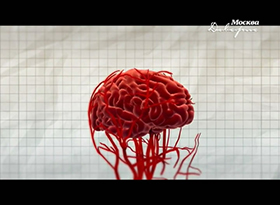ПУБЛИКАЦИИ
Sliding dichotomy compared with fixed dichotomization of ordinal outcome scales in subarachnoid hemorrhage trials Clinical article
- Создано 02.01.2013 14:12
Don Ilodigwe, M. Stat.1,2, Gordon D. Murray, Ph.D.3, Neal F. Kassell, M.D.4, James Torner, Ph.D.5, Richard S. C. Kerr, M.D.6, Andrew J. Molyneux, F.R.C.R.7, and R. Loch Macdonald, M.D., Ph.D.1,2
1Division of Neurosurgery, St. Michael's Hospital, Labatt Family Centre of Excellence in Brain Injury and Trauma Research, Keenan Research Centre in the Li Ka Shing Knowledge Institute of St. Michael's Hospital; 2Department of Surgery, Institute of Medical Science, University of Toronto, Ontario, Canada; 4Department of Neurological Surgery, University of Virginia School of Medicine, Charlottesville, Virginia; 5Department of Epidemiology, University of Iowa, College of Public Health, Iowa City, Iowa; 3Centre for Population Health Sciences, University of Edinburgh Medical School, Edinburgh; 6Department of Neurosurgery, West Wing, John Radcliffe Hospital, Oxford; and 7Oxford Neurovascular and Neuroradiology Research Unit, University of Oxford, United Kingdom
Abbreviations used in this paper: CONSCIOUS-1 = Clazosentan to Overcome Neurological Ischemia and Infarction Occurring After Subarachnoid Hemorrhage; GOS = Glasgow Outcome Scale; GOS-E = extended GOS; ISAT = International Subarachnoid Aneurysm Trial; mRS = modified Rankin Scale; SAH = subarachnoid hemorrhage; WFNS = World Federation of Neurosurgical Societies.
Address correspondence to: R. Loch Macdonald, M.D., Ph.D., Division of Neurosurgery, St. Michael's Hospital, University of Toronto, 30 Bond Street, Toronto, Ontario, Canada M5B 1W8. email: Этот адрес электронной почты защищен от спам-ботов. У вас должен быть включен JavaScript для просмотра..">Этот адрес электронной почты защищен от спам-ботов. У вас должен быть включен JavaScript для просмотра..
Please include this information when citing this paper: published online October 5, 2012; DOI: 10.3171/2012.9.JNS111383.
Related Articles
By Keywords:
clinical trial, statistical analysis, vascular disorders, subarachnoid hemorrhage, vasospasm
Abstract
OBJECT
In randomized clinical trials of subarachnoid hemorrhage (SAH) in which the primary clinical outcomes are ordinal, it has been common practice to dichotomize the ordinal outcome scale into favorable versus unfavorable outcome. Using this strategy may increase sample sizes by reducing statistical power. Authors of the present study used SAH clinical trial data to determine if a sliding dichotomy would improve statistical power.
METHODS
Available individual patient data from tirilazad (3552 patients), clazosentan (the Clazosentan to Overcome Neurological Ischemia and Infarction Occurring After Subarachnoid Hemorrhage trial [CONSCIOUS-1], 413 patients), and subarachnoid aneurysm trials (the International Subarachnoid Aneurysm Trial [ISAT], 2089 patients) were analyzed. Treatment effect sizes were examined using conventional fixed dichotomy, sliding dichotomy (logical or median split methods), or proportional odds modeling. Whether sliding dichotomy affected the difference in outcomes between the several age and neurological grade groups was also evaluated.
RESULTS
In the tirilazad data, there was no significant effect of treatment on outcome (fixed dichotomy: OR = 0.92, 95% CI 0.80–1.07; and sliding dichotomy: OR = 1.02, 95% CI 0.87–1.19). Sliding dichotomy reversed and increased the difference in outcome in favor of the placebo over clazosentan (fixed dichotomy: OR = 1.06, 95% CI 0.65–1.74; and sliding dichotomy: OR = 0.85, 95% CI 0.52–1.39). In the ISAT data, sliding dichotomy produced identical odds ratios compared with fixed dichotomy (fixed dichotomy vs sliding dichotomy, respectively: OR = 0.67, 95% CI 0.55–0.82 vs OR = 0.67, 95% CI 0.53–0.85). When considering the tirilazad and CONSCIOUS-1 groups based on age or World Federation of Neurosurgical Societies grade, no consistent effects of sliding dichotomy compared with fixed dichotomy were observed.
CONCLUSIONS
There were differences among fixed dichotomy, sliding dichotomy, and proportional odds models in the magnitude and precision of odds ratios, but these differences were not as substantial as those seen when these methods were used in other conditions such as head injury. This finding suggests the need for different outcome scales for SAH.
- Удаление каверномы глубинных отделов правого полушария
- Клипирование de novo образованной аневризмы левой СМА
- Клипирование крупной частично тромбированной аневризмы
- Удаление каверномы в сочетании с амигдало-гиппокампэктомией
- Иссечение АВМ после частичной эмболизации композицией onyx
- Клипирование гигантской аневризмы СМА с применением методики ВАК





